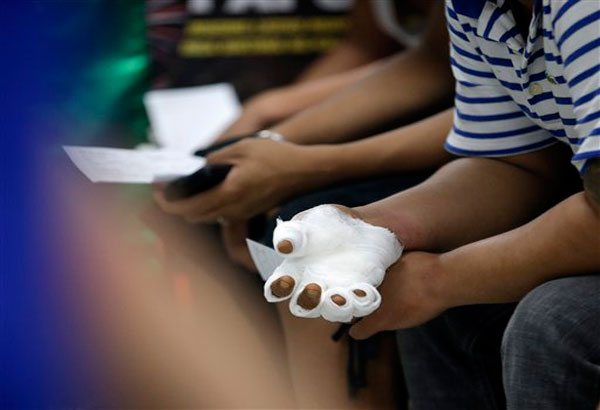Conjoined Pinoy twins survive riskiest surgery yet
February 22, 2004 | 12:00am
Twins from the Philippines joined at the tops of their heads survived their third major operation, the riskiest yet in the long process of giving them separate lives.
After a nine-hour operation Friday, 22-month-old Carl and Clarence Aguirre were wheeled to the pediatric critical care unit to begin adjusting to rerouted circulation systems, said Pamela Adkins, spokeswoman for Montefiore Medical Center.
No detailed comment on the results of the surgery was expected before yesterday’s news conference in New York.
One of the surgeons, Dr. David Staffenberg, said at least one more operation would be necessary before the twins can be separated.
A 16-member medical team — including five anesthesiologists and two lead surgeons — cut into the twins’ fused skulls and divided most of the remaining blood vessels, including at least one of the two major veins that were still connected to both boys’ circulation systems, the hospital said.
The twins risked bleeding, because the veins’ walls are so thin, and the swelling that can damage the boys’ separate brains. Those dangers were avoided in the first two operations, in October and November, but Friday’s surgery was trickier.
"As we move toward the back of the head, the anatomy changes. The veins get a little larger and it’s a little more dense so it’s really going to be a demanding technical exercise for the neurosurgeon," Staffenberg explained.
Dr. James Goodrich, chief of pediatric neurosurgery, said in advance that Clarence, who was born with a better-developed system of veins, would likely get to keep the bulk of the existing system. For Carl, the blood flow would be directed into other existing veins.
Goodrich said last week that the sharing of the veins in the boys’ heads had created a "lake" of blood between their brains.
"We’ve decided to give the lake to Clarence," he said. "What we’re trying to do is reverse the flow in Carl and try to get his blood to flow into deeper veins."
Tissue expanders were inserted under the scalp during the first two operations in hopes of stretching skin for use in covering the skulls later. But they became infected each time and had to be removed, so expanders were not added during Friday’s surgery.
Staffenberg said a fourth operation later this year, and possibly a fifth, would be necessary before the twins can be separated.
The twins and their mother, Arlene Aguirre, have been in New York since September. Both hospitals and the medical team are donating their services.
"This surgery is necessary for my boys to lead a normal life. It is their only chance," Arlene said before Friday’s operation began.
Staffenberg said the twins appeared to be in high spirits as they were wheeled into the operating theater.
"Both were smiling, happy, playing with their toys, giving high-fives and saying ‘bye-bye’ and ‘hello,’" he said. "They were very interactive with their mother and the medical team."
The boys, underweight when they arrived, are learning some of the motor skills they will need when they are separated. Because they are joined at the tops of their heads, they have never walked, stood or even sat up, though they have begun crawling on hands and knees.
Instead of performing one lengthy operation, the medical team at the Montefiore hospital decided to conduct the separation over the course of as many as four shorter operations.
Staffenberg said the strategy seemed to be working. The latest high-tech scans and models of the boys, as well as direct observation, show no sign of brain injury, he said, and meanwhile the brothers are growing bigger and stronger for each operation.
Veins that had been nearly dormant have plumped up, responding to the tying off of other veins, and Clarence’s high blood pressure has improved as Carl’s circulation became more independent, Staffenberg added.
Besides the one or two operations remaining before separation, the boys will have several procedures afterward to reconstruct their skulls.
"By then we’ll have two patients to deal with," Staffenberg said.
Conjoined twins occur in approximately one of every 200,000 live births. Twins joined at the head are extremely rare — representing roughly one in 10 million live births.— AFP
After a nine-hour operation Friday, 22-month-old Carl and Clarence Aguirre were wheeled to the pediatric critical care unit to begin adjusting to rerouted circulation systems, said Pamela Adkins, spokeswoman for Montefiore Medical Center.
No detailed comment on the results of the surgery was expected before yesterday’s news conference in New York.
One of the surgeons, Dr. David Staffenberg, said at least one more operation would be necessary before the twins can be separated.
A 16-member medical team — including five anesthesiologists and two lead surgeons — cut into the twins’ fused skulls and divided most of the remaining blood vessels, including at least one of the two major veins that were still connected to both boys’ circulation systems, the hospital said.
The twins risked bleeding, because the veins’ walls are so thin, and the swelling that can damage the boys’ separate brains. Those dangers were avoided in the first two operations, in October and November, but Friday’s surgery was trickier.
"As we move toward the back of the head, the anatomy changes. The veins get a little larger and it’s a little more dense so it’s really going to be a demanding technical exercise for the neurosurgeon," Staffenberg explained.
Dr. James Goodrich, chief of pediatric neurosurgery, said in advance that Clarence, who was born with a better-developed system of veins, would likely get to keep the bulk of the existing system. For Carl, the blood flow would be directed into other existing veins.
Goodrich said last week that the sharing of the veins in the boys’ heads had created a "lake" of blood between their brains.
"We’ve decided to give the lake to Clarence," he said. "What we’re trying to do is reverse the flow in Carl and try to get his blood to flow into deeper veins."
Tissue expanders were inserted under the scalp during the first two operations in hopes of stretching skin for use in covering the skulls later. But they became infected each time and had to be removed, so expanders were not added during Friday’s surgery.
Staffenberg said a fourth operation later this year, and possibly a fifth, would be necessary before the twins can be separated.
The twins and their mother, Arlene Aguirre, have been in New York since September. Both hospitals and the medical team are donating their services.
"This surgery is necessary for my boys to lead a normal life. It is their only chance," Arlene said before Friday’s operation began.
Staffenberg said the twins appeared to be in high spirits as they were wheeled into the operating theater.
"Both were smiling, happy, playing with their toys, giving high-fives and saying ‘bye-bye’ and ‘hello,’" he said. "They were very interactive with their mother and the medical team."
The boys, underweight when they arrived, are learning some of the motor skills they will need when they are separated. Because they are joined at the tops of their heads, they have never walked, stood or even sat up, though they have begun crawling on hands and knees.
Instead of performing one lengthy operation, the medical team at the Montefiore hospital decided to conduct the separation over the course of as many as four shorter operations.
Staffenberg said the strategy seemed to be working. The latest high-tech scans and models of the boys, as well as direct observation, show no sign of brain injury, he said, and meanwhile the brothers are growing bigger and stronger for each operation.
Veins that had been nearly dormant have plumped up, responding to the tying off of other veins, and Clarence’s high blood pressure has improved as Carl’s circulation became more independent, Staffenberg added.
Besides the one or two operations remaining before separation, the boys will have several procedures afterward to reconstruct their skulls.
"By then we’ll have two patients to deal with," Staffenberg said.
Conjoined twins occur in approximately one of every 200,000 live births. Twins joined at the head are extremely rare — representing roughly one in 10 million live births.— AFP
BrandSpace Articles
<
>
- Latest
- Trending
Trending
Latest
Trending
Latest
Recommended
































